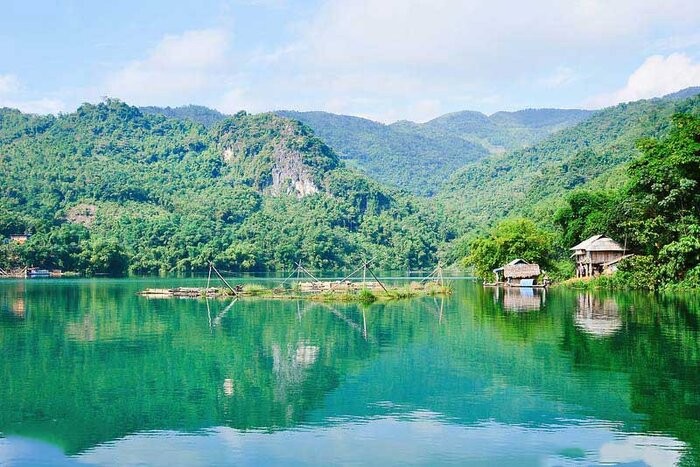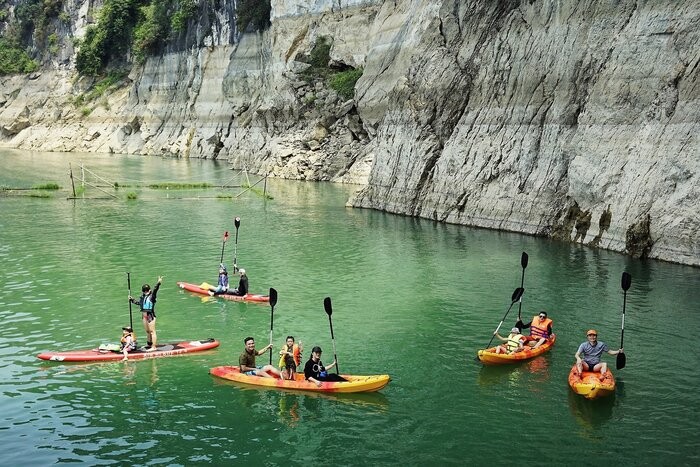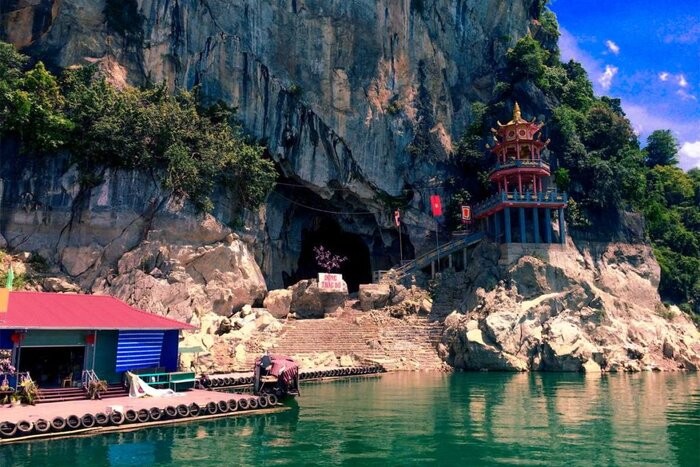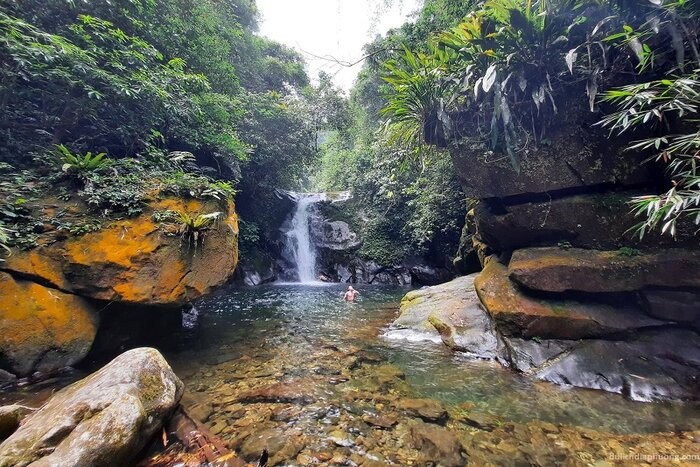Are you planning a trip to Vietnam and wondering what are the main attractions in the Thung Nai area? SIXT.VN offers seamless travel experiences, allowing you to discover the hidden gem of Thung Nai, Hoa Binh Province. Nestled amidst stunning landscapes and serene waterways, Thung Nai is a perfect escape. With SIXT.VN, explore this beautiful destination with ease, enjoying convenient transportation, comfortable accommodations, and unforgettable tours. Uncover the beauty of Thung Nai, your dream vacation with boat tours, floating market visits, and cultural exploration.
1. Discovering Thung Nai: An Overview of Hoa Binh’s Hidden Gem
Thung Nai, located in the Hoa Binh Province of Vietnam, is a captivating area known for its stunning natural beauty and tranquil atmosphere. Situated in the Cao Phong District, it lies approximately 25 kilometers from Hoa Binh City. Historically, this area was the home of the Muong ethnic minority, adding a rich cultural dimension to its scenic appeal. Thung Nai’s key feature is the picturesque reservoir, formed by the Da River. This reservoir is surrounded by emerald-green waters, rolling hills, and striking limestone mountains, creating a landscape that’s often compared to “Ha Long Bay on land.”
Boat tours are a popular way to explore the area, offering serene views of scattered islands and traditional floating houses. Thung Nai also boasts mesmerizing viewpoints, inviting visitors to soak in panoramic vistas. Beyond its visual allure, the region offers opportunities for outdoor activities like hiking and trekking, as well as cultural encounters in nearby villages. Thung Nai stands as a unique destination, providing a peaceful retreat amidst the natural beauty of northern Vietnam. The construction of a hydroelectric dam transformed the landscape, turning high mountains into graceful islets, enhancing its appeal and making it a must-visit attraction in the Mai Chau region.
 Thung Nai Lake view from a distance, showcasing the green hills and calm waters
Thung Nai Lake view from a distance, showcasing the green hills and calm waters
2. What Are The Key Attractions To Visit In Thung Nai?
What exactly can you see and do in Thung Nai? Here’s a breakdown of the main attractions that make this area special:
2.1. Serene Landscapes around Song Da Lake
What’s a must-see when visiting Thung Nai? The centerpiece of Thung Nai is undoubtedly Song Da Lake. Hoa Binh is graced with numerous attractions, with Thung Nai serving as a hub for these wonders. Among them, the standout gem is Song Da Lake, renowned for its vastness and significance as a water reservoir supporting the Hoa Binh Hydropower Plant. To truly appreciate the splendor of this locale, a boat excursion is highly recommended.
Navigating the tranquil waters of Song Da Lake, visitors find themselves immersed in the poetic beauty that unfolds along the shores. The best way to fully appreciate this stunning body of water is with a boat trip, allowing you to take in the panoramic views.
 Boat excursion on Song Da Lake with hills and floating houses in view
Boat excursion on Song Da Lake with hills and floating houses in view
2.2. Visiting Thac Bo Floating Market
What unique cultural experiences await in Thung Nai? The bustling scene comes to life early in the day as numerous trading boats congregate, infusing the market with a lively and energetic atmosphere. For a unique cultural experience, visit the Thac Bo Floating Market. Thac Bo market near Bo Waterfall only opens once every Sunday from dawn. Coming to Thac Bo market, you can shop for attractive specialties in Thung Nai. Besides, you will also be immersed in the bustling and joyful atmosphere with the highland people in Thung Nai.
 Thac Bo Floating Market on a river with small boats
Thac Bo Floating Market on a river with small boats
2.3. Enchanting Ambiance in Thac Bo Cave
What natural wonders can be explored near Thac Bo Market? Enhancing the allure of the market, Bo Waterfall is made even more captivating by the adjacent cave. While not as expansive as Mai Chau’s Mo Luong Cave, it continues to draw thousands of visitors annually. Witness the enchanting spectacle of numerous stalactites sparkling like diamonds as light permeates the cave. The diverse array of full-sized and uniquely shaped formations vividly showcases the creative wonders of Mother Nature.
Adjacent to the market, Thac Bo Cave offers a glimpse into the natural wonders hidden within the region. The diverse array of formations vividly showcases the creative wonders of Mother Nature.
 Inside Thac Bo Cave showcasing stalactites and rock formations
Inside Thac Bo Cave showcasing stalactites and rock formations
2.4. Enjoying the Beauty of Trach Stream
What’s a refreshing activity to enjoy during the summer in Thung Nai? Similar to the stream at Go Lao Waterfall, Trach Stream stands as a natural bathing pool that is a must-experience during the summer months. The pristine and refreshing waters meander through smooth, rolling stones, instantly providing a sensation of relaxation that is not to be missed.
For a refreshing experience, especially during the warmer months, Trach Stream provides a natural bathing pool. The pristine and refreshing waters meander through smooth, rolling stones, instantly providing a sensation of relaxation.
 Trach Stream flowing through rocks with clear water
Trach Stream flowing through rocks with clear water
3. Planning Your Trip: Practical Information and Essential Tips
What are the best ways to get to Thung Nai, and what should you keep in mind for a safe trip?
3.1. How to Travel to Thung Nai Hoa Binh?
How can I reach Thung Nai from Hanoi? There are several ways to travel from Hanoi to Thung Nai Hoa Binh. You can consult some ways below:
- By Car: Thung Nai is approximately a 2.5 to 3-hour drive from Hanoi. Take the route towards Hoa Binh City, then follow the road to Cao Phong District, where Thung Nai is located.
- By Bus: Several bus companies operate services from Hanoi to Hoa Binh City. From Hoa Binh City, you can hire a local taxi or use other local transportation options to reach Thung Nai.
- By Motorbike: If you’re an adventurous traveler, you can rent a motorbike in Hanoi and ride to Thung Nai Hoa Binh. The route offers scenic views of the countryside. Ensure that you’re comfortable with local traffic rules and road conditions.
3.2. Safe Travel Tips when Traveling Thung Nai Hoa Binh
What precautions should I take to ensure a safe trip to Thung Nai? Ensuring your safety during your travels to Thung Nai Hoa Binh is crucial. Here are some safety tips to keep in mind:
- Stay informed about the weather conditions, especially during the rainy season. Heavy rainfall may affect road conditions and activities.
- Seek advice from locals or your accommodation provider regarding safe routes, road conditions, and any potential hazards.
- Carry a basic first aid kit, including any personal medications you may need.
- Stay hydrated, especially during outdoor activities, and be mindful of food hygiene.
- Be aware of the terrain if engaging in outdoor activities. Wear appropriate footwear and exercise caution.
According to the Vietnam National Administration of Tourism, it is important to respect local customs and traditions to ensure a smooth and respectful travel experience.
Remember that safety is a priority, and taking proactive measures will contribute to a more enjoyable and secure visit to Thung Nai in Hoa Binh.
4. Cultural Immersion and Local Interactions
How can I respectfully engage with the local culture in Thung Nai?
4.1. Respect Local Customs
What are some cultural norms to be aware of in Thung Nai? When visiting Thung Nai, it’s essential to be mindful and respectful of the local culture, particularly the customs of the Muong ethnic minority. Here are some guidelines to ensure a positive and enriching experience:
- Dress Modestly: When visiting religious sites such as temples or pagodas, or when in local villages, dress modestly. Avoid wearing revealing clothing.
- Remove Shoes: It is customary to remove your shoes before entering someone’s home or certain religious sites. Look for a shoe rack or follow the lead of your host.
- Use Proper Etiquette: When interacting with locals, be polite and respectful. Use both hands when giving or receiving items, especially from elders.
- Ask Permission: Always ask for permission before taking photos of people, especially in rural areas.
- Respect Sacred Sites: Be mindful of sacred sites and follow any rules or guidelines provided. Avoid loud noises or disruptive behavior.
- Learn Basic Phrases: Learning a few basic Vietnamese phrases can go a long way in showing respect and building rapport with locals. Simple greetings like “Xin chào” (hello) and “Cảm ơn” (thank you) are always appreciated.
4.2. Supporting Local Economy
How can my visit contribute positively to the local community? Supporting the local economy not only enriches your travel experience but also helps to sustain the communities you visit. Here are some ways to contribute positively to the local economy in Thung Nai:
- Shop at Local Markets: Instead of buying souvenirs from large commercial stores, visit local markets like the Thac Bo Floating Market. This supports local artisans and farmers directly.
- Eat at Local Restaurants: Dine at family-owned restaurants and eateries. This helps support local families and gives you an authentic taste of the region’s cuisine.
- Stay in Local Guesthouses or Homestays: Opt for locally-owned guesthouses or homestays rather than international hotel chains. This ensures that your money stays within the community.
- Hire Local Guides: Engage local guides for tours and excursions. They can provide insights into the area’s history, culture, and natural environment.
- Purchase Handicrafts: Buy handicrafts and artwork directly from local artisans. This provides them with income and helps preserve traditional crafts.
- Participate in Community-Based Tourism: Look for community-based tourism initiatives that benefit local residents. These may include cultural performances, cooking classes, or village tours.
5. Planning Your Itinerary: Suggested Activities and Tours
What are some must-do activities and tour options for my trip to Thung Nai?
5.1. Boat Tours on Song Da Lake
Why should I consider a boat tour on Song Da Lake? Taking a boat tour on Song Da Lake is a quintessential Thung Nai experience, offering a serene and picturesque exploration of the region’s natural beauty. Here’s why it should be a highlight of your itinerary:
- Scenic Views: Boat tours provide unparalleled views of the emerald-green waters, limestone karsts, and lush hills that define the Thung Nai landscape.
- Tranquil Experience: Escape the hustle and bustle of city life and immerse yourself in the tranquility of the lake. The gentle lapping of water against the boat and the fresh air create a relaxing atmosphere.
- Exploration of Islands: Discover hidden islands and explore unique rock formations that dot the lake. Many tours include stops at small islands where you can disembark and take photos.
- Floating Houses: Get a glimpse of local life by observing the traditional floating houses that dot the lake. These homes provide a unique insight into the lifestyle of the people who live on the water.
- Photography Opportunities: Capture stunning photos of the landscape from various vantage points on the lake. The changing light throughout the day offers different perspectives and photo opportunities.
- Relaxation: Enjoy a leisurely cruise on the lake, taking in the beauty of the surroundings. Some tours include opportunities for swimming or fishing.
5.2. Hiking and Nature Walks
What are some scenic trails for hiking and nature walks in Thung Nai? Exploring Thung Nai on foot through hiking and nature walks offers a deeper connection with the region’s natural beauty. Here are some scenic trails to consider for your itinerary:
- Around Thung Nai Valley: Embark on a leisurely walk through the valley, taking in the sights and sounds of rural Vietnam. Pass through rice paddies, local villages, and fruit orchards.
- Hilltop Treks: Challenge yourself with a trek to the top of one of the surrounding hills. The panoramic views from the summit are well worth the effort.
- Waterfall Hikes: Discover hidden waterfalls and natural pools by hiking through the lush forests of Thung Nai. Be sure to wear appropriate footwear as the terrain can be uneven.
- Guided Nature Walks: Join a guided nature walk led by a local expert who can share insights into the region’s flora, fauna, and geology.
According to a study by the Adventure Travel Trade Association, activities like hiking and nature walks contribute significantly to sustainable tourism by promoting environmental awareness and supporting local economies.
5.3. Visiting Local Villages
What cultural experiences can I have by visiting local villages near Thung Nai? Visiting local villages near Thung Nai offers a unique opportunity to immerse yourself in the culture and traditions of the Muong ethnic minority. Here’s what you can expect:
- Traditional Architecture: Observe the traditional stilt houses that are characteristic of the region. These houses are built on stilts to protect against flooding and provide ventilation.
- Cultural Performances: Attend a cultural performance featuring traditional music, dance, and storytelling. These performances offer a glimpse into the rich cultural heritage of the Muong people.
- Handicraft Workshops: Participate in a handicraft workshop where you can learn traditional weaving, embroidery, or pottery techniques. These workshops provide an opportunity to interact with local artisans and create your own souvenirs.
- Homestays: Stay in a local homestay and experience daily life in a Muong village. Share meals with your host family, learn about their customs, and gain a deeper understanding of their way of life.
- Local Markets: Visit local markets and sample traditional foods and beverages. This is a great way to support local farmers and artisans while experiencing the flavors of the region.
6. Accommodation Options in Thung Nai
What types of accommodations are available in Thung Nai, and how do I choose the best one for my needs?
6.1. Hotels and Resorts
What are the benefits of staying in a hotel or resort in Thung Nai? Hotels and resorts in Thung Nai provide a range of amenities and services designed to ensure a comfortable and convenient stay. Here’s what you can expect:
- Comfortable Rooms: Enjoy well-appointed rooms with comfortable beds, private bathrooms, and modern amenities.
- On-Site Dining: Dine at on-site restaurants serving a variety of local and international cuisines.
- Recreational Facilities: Take advantage of recreational facilities such as swimming pools, spas, and fitness centers.
- Concierge Services: Receive assistance with tour bookings, transportation arrangements, and other travel needs from the concierge desk.
- Scenic Locations: Stay in hotels and resorts located in scenic locations with stunning views of the lake and surrounding hills.
According to Booking.com, properties with scenic views and on-site dining options are highly rated by travelers visiting rural destinations like Thung Nai.
6.2. Guesthouses and Homestays
What are the advantages of choosing a guesthouse or homestay in Thung Nai? Guesthouses and homestays in Thung Nai offer a more intimate and authentic travel experience. Here’s what you can expect:
- Local Hospitality: Experience the warmth and hospitality of local hosts who are eager to share their culture and traditions.
- Authentic Cuisine: Enjoy home-cooked meals made with fresh, local ingredients.
- Cultural Immersion: Stay in traditional stilt houses or family homes and gain a deeper understanding of local life.
- Personalized Service: Receive personalized attention and assistance from your hosts who can provide insights into the area’s history, culture, and attractions.
- Budget-Friendly Options: Find budget-friendly accommodation options that are ideal for travelers looking to save money.
6.3. Eco-Lodges and Retreats
What unique experiences can I have at an eco-lodge or retreat in Thung Nai? Eco-lodges and retreats in Thung Nai offer a unique blend of comfort, sustainability, and natural beauty. Here’s what you can expect:
- Sustainable Practices: Stay in eco-friendly accommodations that are designed to minimize their environmental impact.
- Nature-Based Activities: Participate in nature-based activities such as bird watching, hiking, and kayaking.
- Wellness Programs: Rejuvenate your mind, body, and soul with wellness programs such as yoga, meditation, and spa treatments.
- Organic Cuisine: Enjoy meals made with fresh, organic ingredients sourced from local farms.
- Secluded Locations: Escape the crowds and unwind in secluded locations surrounded by lush forests and pristine waters.
7. Culinary Delights: What to Eat in Thung Nai
What are some must-try local dishes in Thung Nai?
7.1. Com Lam (Bamboo Rice)
What makes Com Lam a local specialty? Com Lam is a signature dish of the region, prepared by cooking sticky rice inside bamboo tubes. The bamboo imparts a subtle, smoky flavor to the rice, making it incredibly aromatic and delicious.
According to a survey by the Vietnam Culinary Association, Com Lam is one of the most popular dishes among tourists visiting northern Vietnam.
7.2. Grilled Fish
What is special about the grilled fish in Thung Nai? Fresh fish caught from Song Da Lake is grilled over hot coals and seasoned with local herbs and spices. The result is a flavorful and succulent dish that is best enjoyed with rice and vegetables.
7.3. Hill Chicken
Why should I try the hill chicken dish? Free-range chickens raised in the surrounding hills are known for their tender and flavorful meat. They are often grilled, roasted, or stir-fried with local herbs and spices to create a hearty and satisfying meal.
7.4. Thang Co
What are the ingredients of the traditional Thang Co dish? Thang Co is a traditional dish of the Muong ethnic minority, made with a variety of meats and vegetables. It is a hearty and flavorful dish that is often served during special occasions and festivals.
7.5. Local Vegetables
What unique vegetables can I sample in Thung Nai? Sample a variety of fresh, local vegetables grown in the surrounding hills. These vegetables are often stir-fried, boiled, or added to soups and stews to create healthy and flavorful meals.
8. Essential Tips for International Travelers
What practical information should international travelers know before visiting Thung Nai?
8.1. Visa Requirements
What are the visa requirements for entering Vietnam? Ensure that you have a valid visa for entering Vietnam. Check with your local embassy or consulate for specific requirements and application procedures. Many nationalities can apply for an e-visa online, which simplifies the process.
According to the Vietnam Immigration Department, travelers from certain countries are eligible for visa exemptions, allowing them to stay in Vietnam for a limited number of days without a visa.
8.2. Currency and Payment Methods
What is the local currency, and what payment methods are commonly accepted? The local currency in Vietnam is the Vietnamese Dong (VND). While credit cards are accepted in larger hotels and restaurants, it is advisable to carry cash for smaller establishments and markets. ATMs are widely available in cities and towns.
8.3. Language
How can I overcome the language barrier in Thung Nai? While English is spoken in tourist areas, it is helpful to learn a few basic Vietnamese phrases to facilitate communication with locals. Consider using a translation app or carrying a phrasebook.
8.4. Health and Safety
What health precautions should I take, and how can I stay safe during my trip? Consult with your doctor regarding recommended vaccinations and health precautions for traveling to Vietnam. Carry a basic first aid kit and insect repellent. Be mindful of food hygiene and drink bottled water. Stay informed about local safety conditions and follow the advice of local authorities.
According to the World Health Organization, travelers should ensure that they are up to date on routine vaccinations and take precautions to prevent mosquito bites.
8.5. Transportation
What are the best transportation options for getting around Thung Nai? The most common transportation options for getting around Thung Nai include taxis, motorbikes, and bicycles. Consider hiring a local driver for day trips and excursions. Be sure to negotiate prices in advance.
9. Thung Nai Through the Seasons: When to Visit
What is the best time of year to visit Thung Nai for optimal weather and experiences?
9.1. Spring (March to May)
What can I expect during the spring months in Thung Nai? Spring is a pleasant time to visit Thung Nai, with mild temperatures and blooming flowers. It is an ideal time for hiking, nature walks, and boat tours on Song Da Lake.
9.2. Summer (June to August)
What are the conditions like in Thung Nai during the summer? Summer can be hot and humid in Thung Nai, with occasional rain showers. However, it is also a great time for swimming in Trach Stream and enjoying water-based activities on Song Da Lake.
9.3. Autumn (September to November)
Why is autumn a popular time to visit Thung Nai? Autumn is considered the best time to visit Thung Nai, with cool temperatures, clear skies, and vibrant foliage. It is an ideal time for hiking, photography, and cultural exploration.
9.4. Winter (December to February)
What should I be prepared for if I visit Thung Nai in the winter? Winter can be cool and dry in Thung Nai, with occasional fog and mist. It is a peaceful time to visit, with fewer crowds and opportunities for relaxation and reflection.
10. Conclusion: Your Thung Nai Adventure Awaits
Thung Nai in Hoa Binh unfolds as a picturesque haven, seamlessly blending natural allure, cultural charm, and outdoor pursuits. From the tranquil expanse of Song Da Lake to the floating houses and enchanting boat tours, every facet of Thung Nai offers a unique and captivating experience. Whether exploring caves, admiring panoramic views, or engaging with local communities, each moment in Thung Nai unveils the distinct beauty of Vietnam’s northern landscapes. Ready to explore the beauty of Thung Nai? Let SIXT.VN be your guide. With convenient services for transportation, accommodation, and tours, you can experience the best of Thung Nai hassle-free. Contact SIXT.VN today to plan your adventure and create unforgettable memories in this hidden gem of Vietnam.
Address: 260 Cau Giay, Hanoi, Vietnam
Hotline/Whatsapp: +84 986 244 358
Website: SIXT.VN
FAQ About Thung Nai Attractions
1. What is Thung Nai known for?
- Thung Nai is renowned for its stunning natural landscapes, including Song Da Lake, limestone karsts, and lush hills, often referred to as “Ha Long Bay on land.”
2. How do I get to Thung Nai from Hanoi?
- You can reach Thung Nai by car (2.5 to 3-hour drive), bus to Hoa Binh City followed by a local taxi, or rent a motorbike for an adventurous ride.
3. What activities can I do in Thung Nai?
- Popular activities include boat tours on Song Da Lake, visiting Thac Bo Floating Market, exploring Thac Bo Cave, hiking, and enjoying the beauty of Trach Stream.
4. When is the best time to visit Thung Nai?
- The best time to visit is in the autumn (September to November) for cool temperatures, clear skies, and vibrant foliage.
5. What should I pack for a trip to Thung Nai?
- Pack comfortable clothing, hiking shoes, insect repellent, sunscreen, a hat, and a light jacket for cooler evenings.
6. Are there accommodations available in Thung Nai?
- Yes, you can choose from hotels, resorts, guesthouses, homestays, and eco-lodges to suit your preferences and budget.
7. What local dishes should I try in Thung Nai?
- Must-try dishes include Com Lam (bamboo rice), grilled fish from Song Da Lake, hill chicken, and local vegetables.
8. Is it safe to travel to Thung Nai?
- Yes, Thung Nai is generally safe. Stay informed about weather conditions, seek local advice, carry a first aid kit, and respect local customs.
9. What should I know about local customs in Thung Nai?
- Dress modestly, remove shoes before entering homes or religious sites, use proper etiquette, ask for permission before taking photos, and respect sacred sites.
10. How can I support the local economy in Thung Nai?
- Shop at local markets, eat at local restaurants, stay in local guesthouses or homestays, hire local guides, and purchase handicrafts directly from artisans.



